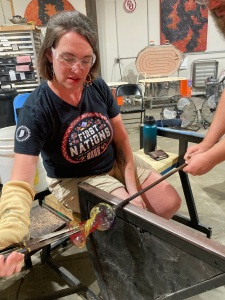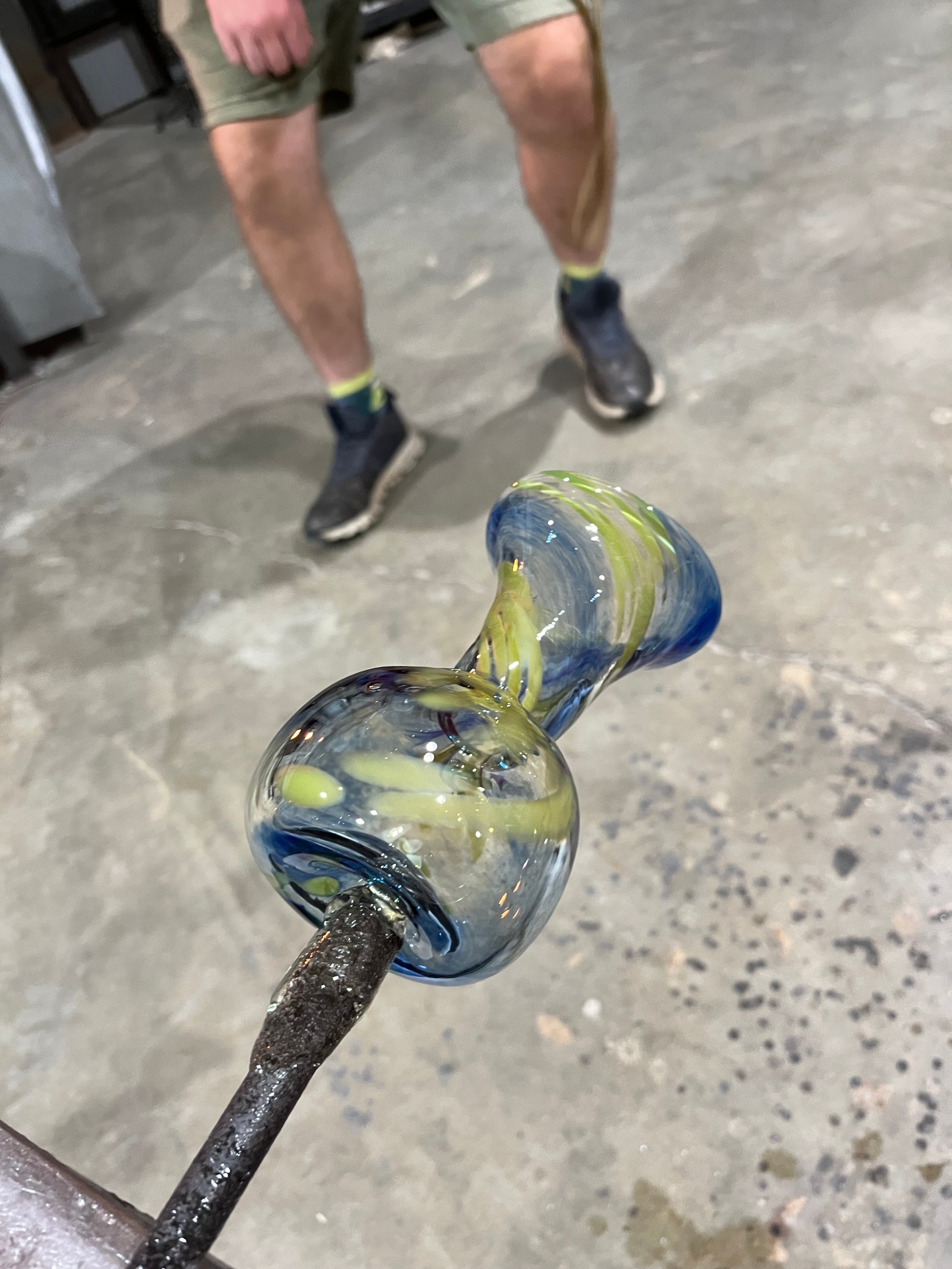“Continue your glass blowing journey with Intermediate glass blowing. In the class you will become more proficient in your basic skills (gathering, marvering, rolling at the bench), continue to perfect the basic cylinder, play with color, learn the basics of the drop neck form, the pulled neck form, be able to make a good punty for a partner, and add some bits.” (From the Bloomington Creative Glass Center’s description for the Intermediate Glass Blowing class (emphasis added))
I earned the title Punty Girl last night in glass blowing class. My classmates harmoniously sing out “Punty” to get my attention and request my assistance. I am honored to serve the role and I enthusiastically offer my punty abilities to my glass blowing classmates. I’ve already made some Weird Al songs variations for myself: Hey There, Punty Girl and Pass the Punty.
“Punty” is a multi-function word. It is the person serving the role. It’s an action performed during glass-blowing. It’s a straight rod with a little dollop of slightly formed gather on the end of it. “Punty” is like the word “Smurf” from the 70s/80s Saturday morning cartoon show. I am a smurfy punty.

The punty serves a specific assistive role for the gaffer, who is the specialist and artisan, the person at the bench who blows the piece, decides on the artistic direction, and coordinates the activities of multiple assistants. We all get a turn being the gaffer in class. Once the gaffer has their cup or vase formed to the desired volume and approximate height, they turn their attention to forming the neck and lip of the vessel. “Punty!” While the gaffer briefly blasts their piece in the reheat furnace to get the bottom soft, the punty takes a small gather of liquid glass on a plain rod and quickly rolls it to a small sticky point on the steel marver table. Like the International Space Station docking an expedition capsule, the gaffer uses forceps to slowly bring in and align the tacky end of the punty with the center of the bottom of their piece. All eyes fixate on that juncture of the blown vessel and the punty. We carefully rotate our rods in unison, turning the piece together and slightly nudging the punty into position. Drops of water sizzle and the glass crackles and splinters as the gaffer uses forceps to place pinches water at the jackline, an indentation they’ve already made where the top of the piece will be.

The class collectively holds their breath as the gaffer gently taps their blowing rod twice with the back end of their jack knife. We can almost hear the silent, hopeful appeals that the punty has sufficiently stuck to the bottom of the vessel, that the vessel remains intact, and that the intended narrowing of the neck becomes the separation point. Like the downhill slope of a rollercoaster, this is the point of transfer of anticipation and tension from strained to release. Either the piece survives or it doesn’t at this juncture.
The weight of the vessel exchanges to the punty and it is free of the blowing rod. Quickly and carefully, the punty takes the piece to the reheat furnace. Everyone exhales and inhales again seeing the piece successfully transferred to the punty and placed back to the reheat furnace without dropping to the floor. The singular focus on the punty connection point relaxes as we each shift our attention and gaze to the next phase of the project. The punty cedes care of the rod and piece back to the gaffer when they’re ready to shape the neck and lip of the vessel. What had been a bubble on the end of the blowing rod is now an open-ended vessel perched on a straight rod.

That watchful, careful role of punty in glass-blowing mirrors how I think of my role with graduate students. Attunement, accompaniment, assistance, presence, awareness, care, flexibility, patience, resourcing, and calm provide support for their middle-space transformations and metamorphoses from one role and life phase to another.
